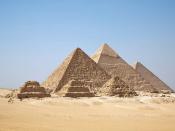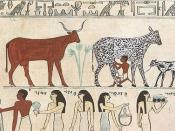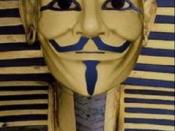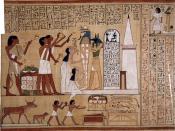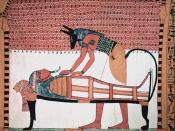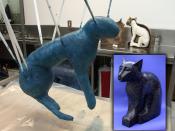Table of Contents ÷ Introductionâ¦â¦â¦â¦â¦â¦â¦â¦â¦â¦â¦â¦â¦â¦â¦â¦â¦â¦â¦2 ÷ General Information, Mainâ¦â¦â¦â¦â¦â¦â¦â¦â¦â¦â¦â¦.3-6 o Mummificationâ¦â¦â¦â¦â¦â¦â¦â¦â¦â¦â¦â¦â¦â¦...3 o Journey to Yaruâ¦â¦â¦â¦â¦â¦â¦â¦â¦â¦â¦â¦â¦â¦..4 o Recitation to the Godsâ¦â¦â¦â¦â¦â¦â¦â¦â¦â¦â¦â¦4 o Myth and Ritualsâ¦â¦â¦â¦â¦â¦â¦â¦â¦â¦â¦â¦â¦â¦.5 o Opening of the Mouth Ceremonyâ¦â¦â¦â¦â¦â¦â¦â¦5 ÷ Conclusionâ¦â¦â¦â¦â¦â¦â¦â¦â¦â¦â¦â¦â¦â¦â¦â¦â¦â¦â¦5-6 ÷ Bibliographyâ¦â¦â¦â¦â¦â¦â¦â¦â¦â¦â¦â¦â¦â¦â¦â¦â¦â¦â¦.7 Egyptian Afterlife Introduction Many ancient civilizations of the world have been unraveled, but one in particular interests me the most. The astonishing beliefs and lifestyle of the ancient Egyptians are unlike any other of its time or any time at all. These Egyptians had developments and beliefs that are still in some ways a mystery, but as the years go by, we begin to learn more. If you ever wondered what the meanings of some burial traditions or what mummies really were, you'll find out as you read along. I will discuss the procedures and beliefs of Egyptian afterlife.
Egyptian Afterlife General/Main Information Once an Egyptian dies, there are several things that can be done with their remains.
One thing that we discovered that can be done with the remains is the process of mummification, which was only performed on certain people. So let's start there.
The process of mummification is the form of embalming practiced by the ancient Egyptians that changed over time from the Old Kingdom (ca. 2750-2250 B.C.), when it was available only to kings, to the New Kingdom (ca. 1539-1070 B.C.), when it was available to everyone. The level of mummification depended on what one could afford. The most fully developed form involved five basic steps: 1. All of the internal organs, except the heart, were removed. Since the organs were the first parts of the body to decompose but were necessary in the afterlife, they were mummified and put in canopic jars that were placed in the tomb at the time of burial. They would take out the stomach and clean it with palm wine. The heart was believed to be the seat of intelligence and emotion and was, therefore, left in the body. The brain, on the other hand, was regarded as having no significant value and, beginning in the New Kingdom, was removed through the nose and discarded.
2. The body was packed and covered with natron, a salty drying agent, and left to dry out for forty to fifty days. By this time all the body's liquid had been absorbed and only the hair, skin, and bones were left.
3. The body cavity was stuffed with resin, sawdust, or linen and shaped to restore the deceased's form and features. They would also fill the body with myrrh and other spices.
4. The body was then tightly wrapped in many layers of linen with numerous good luck charms, or amulets, wrapped between the layers. The most important amulet was the scarab beetle, which was placed over the heart. Jewelry was also placed among the bandages. At each stage of wrapping, a priest recited spells and prayers. This whole procedure could take as long as fifteen days. After the wrapping was complete, the body was put into a shroud. The entire mummification process took about seventy days.
5. Perform the Ceremony of opening the mouth of the mummy - if this were not done the mummy would not be able to eat, drink, breathe or talk. The mummy would then be placed in a coffin, which then would be placed inside a tomb, the greatest of tombs being a pyramid but only Pharaohs and queens could have pyramids built.
Egyptians paid vast amounts of money to have their bodies properly preserved. They would need all the things they had used when they were alive, so their families would put those things in their graves. The Egyptians believed that when they died they would make a journey to another world where they would lead a new life.
The Egyptians believed that to get to the afterlife they would have to pass through a dangerous place with perils such as monsters, boiling lakes, fires and particularly nasty snakes that spat out poison. These evils could be overcome by the right spells and the Egyptians often wrote down the spells on paper and left them in or near the coffin. If they overcame the evils they would reach the gates of Yaru (the Egyptian afterlife) and meet their friends again.
But first they had to pass the greatest test of all in the Hall of Two Truths. This test involved weighing the heart, the only organ which had been left in the body. The heart was placed on one side of a balance and in the other side was placed the Feather of Truth: the Feather of Truth held all the lies and sins of their past life. The 3 great gods, Osiris, Anubis and Thoth, decided the result of the weighing. If the heart passed the test then the dead person was allowed to enter the gates of Yaru. This was where he went to receive his eternal reward where he wandered the shadow land that was the double of the Nile Delta. No famine or sorrows bothered him in this blessed afterlife. But if the heart failed the test then a terrifying monster known as the "Devourer" ate it. The devourer was part crocodile, part hippopotamus, and part lion and once it had eaten a heart the dead person was gone forever. Other translations just believed that if the heart weighed too heavy, he would be thrown to the animal gods who tear him to shreds.
Here, I have found a recitation that some may have said to the Gods upon his/her encounter with them: " Homage to thee, O great God, Lord of Maati! I have come unto thee, O my Lord, and I have brought myself hither that I may behold thy beauties. I know thee, I know thy name, I know the names of the forty-two Gods who live with thee in the Hall of Maati...I have not committed sins against men. I have not opposed my family and kinfolk. I have not acted fraudently in the Seat of Truth. I have not known men who were of no account. I have not defrauded the humble man of his property. I have not done what the gods abominate. I have not vilified a slave to his master. I have not inflicted pain. I have not caused anyone to go hungry. I have not made any man to weep. I have not committed murder....I have not encroached on the fields (of others). I have not added to the weights of the scales...I have not driven the cattle away from their pastures. I have not snared the geese in the goose-pens of the gods. I have not caught fish with bait made of the bodies of the same kind of fish. I have not stopped water when it should flow...I am pure, I am pure. I am pure... " This recitation, when studied, was seen as a negative one. Instead of stating what the Ka had done, the Ka stated what he has not done. The Ka was the duplicate being that was stored in the heart as a vital force possessed by every being. In addition to a ka, each person had a ba. The ba was the soul of the person. After death, the ka and the ba were united into one entity called the akh, which is an aspect of the sun. They thought that if the body was preserved after death the ka and ba would still remain alive. This is why the Egyptians thought mummification was so important.
Myth and Rituals A popular idea of death and rebirth was based on the legend of King Osiris, whom the Egyptians believed was killed and dismembered by his jealous brother Seth, reassembled by his faithful wife Isis, and brought back to life by his son Horus. When the Opening of the Mouth ceremony was done at Egyptian funerals, it was a reenactment of the ceremony Horus had performed for his father. After his rebirth Osiris became known as the god of the underworld.
The Opening of the Mouth Ceremony On the seventieth day after a person's death, when the embalming and wrapping were completed, the mummy was placed in a coffin and taken to the tomb. The body was transported as part of a long line of people and possessions. Close to the mummy were two women representing the goddess Isis and her sister Nephthys. Behind these two was a group including mourners, priests, and servants carrying tomb furnishings. The canopic chest with the mummy's internal organs was carried separately in line. One of the priests burned incense and sprinkled milk along the path. At the tomb, the group was met by dancers and a priest who read spells in honor of the dead.
Next came the very important Opening of the Mouth ceremony, based on the Osiris legend. A priest wearing a jackal-headed mask representing the god Anubis held the mummy's coffin upright while another priest touched the mouth of the mummy with ritual instruments. The Egyptians believed that from a person's death until the performance of this ceremony the body could not hear, see, or speak. Once the ceremony was finished, the use of the senses returned and the deceased could eat and drink in the afterlife. After the ceremony an offering of food, ointment, and clothing was given to the deceased.
With this completed, a large funerary banquet was enjoyed by the mourners, with entertainment in praise of the dead provided by musicians and dancers. While the banquet was going on, the deceased was placed inside the tomb, and the footsteps of those who had been inside were swept away. Now the deceased's soul could return to the body.
Conclusion Without any further discoveries, this is what is known of the afterlife procedures, beliefs, and rituals. Of course, their beliefs are directly linked with the Egyptian religion, just like other religions have their beliefs of a blissful afterlife. The Egyptian polytheistic views are unique though, and strongly emphasize the preservation of the physical body. Like the Hindu belief of reincarnation, the Egyptian beliefs slightly resemble that idea of being brought back to life. As aforementioned, the myth of Osiris claims he was reincarnated by his son, and could possibly mean that those who die strive for the same goal of being brought back.
One thing that I did not find was anything regarding to Ancient Egyptians having a religious law that would determine if the heart would fail or pass. From previous education, though, I remember that Egyptians did have a Code to live by, such as the Code of Hammurabi and rules for praising each divine being. But the Code was more of a sort of order of government instead of an order of religion. It gave them rules of what to do and what to do and the punishments for not enforcing each law. Unlike Christianity and some other religions that give sets of rules to live by day by day, the ancient Egyptian religion, from my knowledge, only gave sets of rules of how to respect and praise the Gods and Goddesses.
We still have much to learn about the ancient Egyptians and their customs. The unique characteristics of this culture definitely draw my interest, but after researching and analyzing, I find the ancient Egyptians fairly simple-minded in the lifestyle area but impressively advanced in technology compared to the rest of the world at that time. I also wonder, because of their simplicity in beliefs, how these beliefs began and who introduced their religion.
Bibliography: Brewer, Douglas, and Emily Teeter. Egypt and the Egyptians. Cambridge: Cambridge University Press, 1999.
Spencer, A.J. Death in Ancient Egypt. New York: Penguin Books, 1982.
http://www.bergen.org/AAST/Projects/Egypt/religion_report.html http://www.paganculture.com/egyptian.html (and other website)
